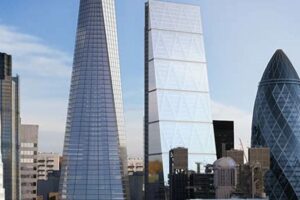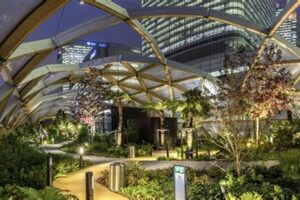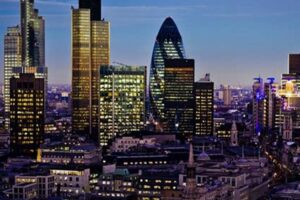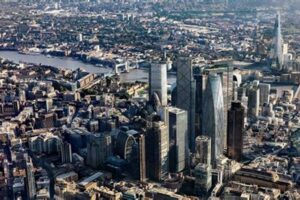London’s Upcoming Skyscrapers: Shaping the City’s Skyline
London’s skyline is constantly evolving, with new skyscrapers reshaping the urban landscape. These architectural marvels not only provide stunning views but also contribute to the city’s economic growth and global competitiveness.
The construction of skyscrapers in London has a long history, dating back to the early 20th century. However, the recent surge in high-rise developments is unprecedented, driven by factors such as population growth, increased demand for office space, and the desire to create iconic structures that symbolize London’s status as a world-class city.
Some of the most notable upcoming skyscrapers in London include:
- The Tulip: A 305-meter-tall observation tower designed by Foster + Partners, offering panoramic views of the city.
- 22 Bishopsgate: A 278-meter-tall office tower designed by PLP Architecture, featuring innovative sustainability features.
- One Nine Elms: A 220-meter-tall residential tower designed by Kohn Pedersen Fox Associates, offering luxury apartments with stunning views of the River Thames.
These skyscrapers, along with many others currently under construction or in the planning stages, are transforming London’s skyline and contributing to the city’s economic and cultural vitality.
1. Height
The height of London’s upcoming skyscrapers is a defining characteristic that sets them apart from previous generations of buildings in the city. By pushing the boundaries of architectural height, these skyscrapers are reshaping London’s skyline and making a statement about the city’s ambition and global significance.
There are several reasons why developers are choosing to build taller and taller skyscrapers in London. One reason is the increasing demand for office space in the city’s central business district. As more and more businesses relocate to London, the demand for office space has outstripped supply, leading to rising rents and a shortage of available space. Skyscrapers provide a solution to this problem by allowing businesses to stack their operations vertically, rather than horizontally.
Another reason for the increasing height of London’s skyscrapers is the desire to create iconic landmarks that will become symbols of the city. In recent years, London has seen the construction of several skyscrapers that have become instantly recognizable landmarks, such as The Shard and the Gherkin. These skyscrapers have helped to put London on the map as a global hub for architecture and design.
The height of London’s upcoming skyscrapers also has a number of practical benefits. For example, taller buildings can offer better views, which can be a major selling point for residential and commercial tenants. Additionally, taller buildings can be more energy-efficient, as they can take advantage of natural ventilation and daylighting.
However, the increasing height of London’s skyscrapers also presents some challenges. One challenge is the need for specialized engineering and construction techniques to ensure that these buildings are safe and stable. Another challenge is the potential impact on the city’s infrastructure, such as transportation and utilities.
Overall, the increasing height of London’s upcoming skyscrapers is a reflection of the city’s ambition, global significance, and commitment to innovation. These skyscrapers are not only reshaping the city’s skyline but also contributing to its economic growth and cultural vitality.
2. Design
The design of London’s upcoming skyscrapers is a key factor in their appeal and significance. These skyscrapers showcase a diverse range of architectural styles, from the futuristic and organic to the sleek and minimalist, reflecting the city’s global outlook and its commitment to innovation.
One of the most striking examples of the diverse design approaches is The Tulip, a 305-meter-tall observation tower designed by Foster + Partners. The Tulip’s design is inspired by the shape of a tulip flower, with a bulbous top and a slender stem. The tower’s facade is made of glass and steel, giving it a futuristic and ethereal appearance.
In contrast to The Tulip’s organic form, 22 Bishopsgate is a sleek and minimalist skyscraper designed by PLP Architecture. The building’s facade is made of glass and metal, and its form is characterized by sharp angles and clean lines. 22 Bishopsgate is a striking example of the modernist architectural style, which emphasizes simplicity and functionality.
The diverse design approaches of London’s upcoming skyscrapers reflect the city’s global outlook and its commitment to innovation. These skyscrapers are not only shaping the city’s skyline but also contributing to its cultural and economic vitality.
The design of London’s upcoming skyscrapers is also influenced by a number of practical considerations. For example, the use of glass and steel in many of these buildings helps to reduce weight and improve energy efficiency. Additionally, the incorporation of green roofs and other sustainable features helps to minimize the environmental impact of these buildings.
Overall, the design of London’s upcoming skyscrapers is a key factor in their appeal and significance. These skyscrapers showcase a diverse range of architectural styles, reflecting the city’s global outlook and its commitment to innovation.
3. Sustainability
In recent years, there has been a growing emphasis on sustainability in the design and construction of skyscrapers. This is due to a number of factors, including the increasing awareness of the environmental impact of buildings, the rising cost of energy, and the growing demand for green buildings from tenants and investors.
- Energy efficiency: Many upcoming skyscrapers in London are incorporating energy-efficient features such as LED lighting, double-glazed windows, and efficient HVAC systems. These features can significantly reduce the building’s energy consumption, which can lead to lower operating costs and a reduced carbon footprint.
- Water conservation: Rainwater harvesting systems are becoming increasingly common in London’s skyscrapers. These systems collect rainwater from the roof of the building and store it in a cistern for later use. Rainwater can be used for a variety of purposes, such as irrigation, flushing toilets, and washing cars. This can help to reduce the building’s reliance on the municipal water supply and conserve water.
- Green roofs: Green roofs are another popular sustainability feature in London’s skyscrapers. Green roofs are covered in vegetation, which can help to insulate the building, reduce stormwater runoff, and improve air quality. Green roofs can also provide a habitat for wildlife and create a more pleasant environment for building occupants.
- Sustainable materials: Many upcoming skyscrapers in London are using sustainable materials in their construction. These materials include recycled steel, low-VOC paints, and FSC-certified wood. Sustainable materials can help to reduce the environmental impact of the building and create a healthier indoor environment.
The incorporation of sustainability features in London’s upcoming skyscrapers is a positive trend that is helping to make the city more sustainable and resilient. These features can reduce the environmental impact of buildings, lower operating costs, and create a more comfortable and healthy indoor environment for occupants.
Mixed-use
The mixed-use nature of London’s upcoming skyscrapers is a key factor in their appeal and significance. By combining residential, commercial, retail, and leisure spaces within a single building, these skyscrapers create vibrant and diverse urban environments that cater to a wide range of needs.
There are several reasons why developers are choosing to build mixed-use skyscrapers in London. One reason is the increasing demand for urban living. As more and more people move to cities, the demand for housing, office space, and retail space is increasing. Mixed-use skyscrapers can help to meet this demand by providing a variety of options within a single building.
Another reason for the popularity of mixed-use skyscrapers is the desire to create more sustainable and livable cities. By combining different uses within a single building, mixed-use skyscrapers can reduce the need for car travel and promote walking and cycling. Additionally, mixed-use skyscrapers can help to create a more vibrant and active street life, which can benefit businesses and residents alike.
There are many examples of mixed-use skyscrapers in London. One example is The Shard, which combines residential apartments, offices, retail space, and a hotel within a single building. Another example is 22 Bishopsgate, which combines offices, retail space, and a public viewing gallery.
Mixed-use skyscrapers are playing an increasingly important role in shaping London’s skyline and urban environment. By combining different uses within a single building, these skyscrapers are helping to create more sustainable, livable, and vibrant cities.
4. Transport
The integration of skyscrapers with public transport hubs is a key factor in their sustainability and appeal. By providing easy access to public transport, these skyscrapers reduce the need for car travel, which can help to reduce traffic congestion and pollution. Additionally, integrating skyscrapers with public transport hubs can make them more accessible to a wider range of people, including those who do not own cars.
- Proximity to public transport: Many upcoming skyscrapers in London are being built in close proximity to public transport hubs, such as train stations andstations. This makes it easy for residents and workers to access public transport, which can reduce traffic congestion and pollution.
- Direct access to public transport: Some skyscrapers are being built with direct access to public transport hubs. This makes it even easier for people to use public transport, as they do not have to leave the building to access the station.
- Integrated public transport hubs: Some skyscrapers are being built as part of integrated public transport hubs. These hubs combine a variety of transport options, such as trains,s, and buses, in a single location. This makes it easy for people to transfer between different modes of transport, which can reduce travel time and congestion.
- Reduced car travel: By integrating skyscrapers with public transport, developers can encourage people to use public transport instead of driving. This can help to reduce traffic congestion and pollution, and can also make the city more livable and sustainable.
The integration of skyscrapers with public transport hubs is a positive trend that is helping to make London a more sustainable and livable city. By reducing traffic congestion and pollution, and by making it easier for people to use public transport, these skyscrapers are helping to create a more sustainable and equitable city for all.
5. Views
The breathtaking panoramic views offered by the upper floors of London’s upcoming skyscrapers are a key factor in their appeal and significance. These views provide a unique perspective on the city, allowing residents, workers, and visitors to enjoy stunning vistas of London’s iconic landmarks and cityscape.
The views from these skyscrapers are not only aesthetically pleasing but also have a number of practical benefits. For example, the views can help to reduce stress and improve mood, and can also provide a sense of place and belonging. Additionally, the views can be used for educational purposes, as they provide a unique opportunity to learn about London’s history and geography.
The importance of views in London’s upcoming skyscrapers is reflected in the fact that many developers are incorporating observation decks and other public viewing areas into their designs. These spaces provide visitors with the opportunity to experience the breathtaking views from the upper floors of these skyscrapers. For example, The Shard, one of London’s tallest skyscrapers, has a public viewing gallery on the 72nd floor that offers 360-degree views of the city.
The views from London’s upcoming skyscrapers are a valuable asset to the city. They provide residents, workers, and visitors with a unique perspective on London, and can have a number of positive benefits for health and well-being. As London continues to grow and develop, it is important to ensure that the city’s skyscrapers continue to offer these breathtaking views.
6. Investment
The construction of skyscrapers in London represents a significant investment in the city’s economy and infrastructure. These investments can have a number of positive benefits, including:
- Job creation: The construction of skyscrapers creates jobs for architects, engineers, construction workers, and other professionals.
- Economic growth: The construction of skyscrapers can stimulate economic growth by increasing demand for goods and services.
- Improved infrastructure: The construction of skyscrapers can lead to improvements in infrastructure, such as new or upgraded transportation links.
- Increased tax revenue: The construction of skyscrapers can increase tax revenue for the city, which can be used to fund public services.
In addition to these economic benefits, the construction of skyscrapers can also have a number of positive social benefits, such as:
- Increased housing supply: The construction of skyscrapers can increase the supply of housing in the city, which can help to reduce housing costs.
- Improved quality of life: The construction of skyscrapers can improve the quality of life for residents by providing access to amenities such as green spaces, retail, and restaurants.
- Increased tourism: The construction of skyscrapers can attract tourists to the city, which can generate revenue and create jobs.
The construction of skyscrapers is a complex and challenging undertaking, but it can also be a very rewarding one. By investing in skyscrapers, London is investing in its future prosperity and growth.
7. Landmark
London’s upcoming skyscrapers are not just buildings; they are symbols of the city’s ambition, innovation, and global significance. These skyscrapers are becoming iconic landmarks, reshaping London’s skyline and contributing to its global recognition.
There are several reasons why London’s upcoming skyscrapers are becoming iconic landmarks. One reason is their sheer height and scale. These skyscrapers are among the tallest buildings in Europe, and their height makes them impossible to miss. Another reason is their unique and innovative design. Many of these skyscrapers are designed by world-renowned architects, and their designs are often praised for their beauty and originality.
The iconic status of London’s upcoming skyscrapers has a number of benefits for the city. First, these skyscrapers attract tourists from all over the world. Visitors come to London to see these architectural wonders and to experience the city’s vibrant culture. Second, these skyscrapers help to promote London as a global business center. The presence of these skyscrapers shows that London is a city that is open to investment and innovation.
The construction of iconic skyscrapers is a complex and challenging undertaking, but it is one that is essential for London’s continued success. By investing in these skyscrapers, London is investing in its future prosperity and growth.
Here are some examples of iconic skyscrapers in London:
- The Shard
- The Gherkin
- One Canada Square
- 22 Bishopsgate
- The Tulip
These skyscrapers are all unique in their own way, but they share a common goal: to make London a more iconic and recognizable city.
FAQs about London’s Upcoming Skyscrapers
London’s upcoming skyscrapers are a major topic of interest and discussion. Here are some frequently asked questions about these iconic structures:
Question 1: What are the tallest upcoming skyscrapers in London?
Answer: The tallest upcoming skyscraper in London is The Tulip, which will be 305 meters tall. Other tall upcoming skyscrapers include 22 Bishopsgate (278 meters) and One Nine Elms (220 meters).
Question 2: When will these skyscrapers be completed?
Answer: The completion dates for these skyscrapers vary. The Tulip is expected to be completed in 2025, 22 Bishopsgate in 2024, and One Nine Elms in 2022.
Question 3: What is the purpose of these skyscrapers?
Answer: These skyscrapers will serve a variety of purposes, including residential, commercial, retail, and leisure. Some of the skyscrapers will also have public observation decks, offering visitors stunning views of London.
Question 4: How will these skyscrapers impact London’s skyline?
Answer: These skyscrapers will have a major impact on London’s skyline, making it even more iconic and recognizable. The skyscrapers will be visible from all over London, and they will become new landmarks for the city.
Question 5: Are these skyscrapers sustainable?
Answer: Many of the upcoming skyscrapers in London are being designed with sustainability in mind. These skyscrapers will incorporate features such as energy-efficient lighting, rainwater harvesting, and green roofs.
Question 6: How much will these skyscrapers cost to build?
Answer: The cost of constructing these skyscrapers will vary depending on their size and complexity. However, it is estimated that the total cost of constructing all of the upcoming skyscrapers in London will be in the billions of pounds.
These are just a few of the frequently asked questions about London’s upcoming skyscrapers. As these skyscrapers continue to be built, they will have a major impact on the city’s skyline, economy, and culture.
Transition to the next article section:
The construction of these skyscrapers is a major undertaking, but it is one that is essential for London’s continued success. By investing in these skyscrapers, London is investing in its future prosperity and growth.
Tips for Investing in London’s Upcoming Skyscrapers
Investing in London’s upcoming skyscrapers can be a lucrative opportunity, but it is important to do your research and understand the risks involved. Here are a few tips to help you get started:
Tip 1: Do your research
Before investing in any skyscraper, it is important to do your research and understand the project. This includes understanding the developer’s track record, the location of the skyscraper, and the amenities that will be offered.
Tip 2: Consider the long-term
Skyscrapers are long-term investments. It can take several years for a skyscraper to be completed, and even longer for it to appreciate in value. It is important to be patient and to have a long-term investment horizon.
Tip 3: Diversify your portfolio
Don’t put all of your eggs in one basket. Diversify your portfolio by investing in a variety of skyscrapers in different locations. This will help to reduce your risk.
Tip 4: Work with a reputable broker
When investing in a skyscraper, it is important to work with a reputable broker. A good broker will be able to provide you with sound advice and help you to find the best investment opportunities.
Tip 5: Be prepared for risks
Investing in skyscrapers involves risk. There is always the possibility that a project will be delayed, or that the value of the skyscraper will decline. It is important to be prepared for these risks and to have a contingency plan in place.
By following these tips, you can increase your chances of success when investing in London’s upcoming skyscrapers.
Summary of key takeaways or benefits:
- Investing in London’s upcoming skyscrapers can be a lucrative opportunity.
- It is important to do your research and understand the risks involved.
- By following these tips, you can increase your chances of success.
Transition to the article’s conclusion:
If you are considering investing in London’s upcoming skyscrapers, it is important to do your research and understand the risks involved. By following these tips, you can increase your chances of success.
Conclusion
London’s upcoming skyscrapers are a testament to the city’s ambition, innovation, and global significance. These architectural marvels are not only reshaping the city’s skyline but also contributing to its economic growth and cultural vitality.
The construction of skyscrapers in London is a complex and challenging undertaking, but it is one that is essential for the city’s continued success. By investing in these skyscrapers, London is investing in its future prosperity and growth. These skyscrapers will continue to attract tourists, businesses, and residents alike, making London a more vibrant and exciting city to live in.







